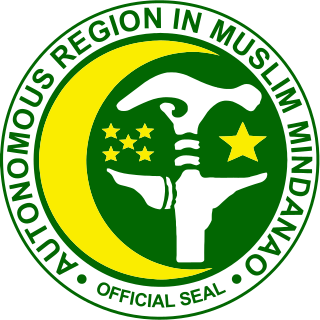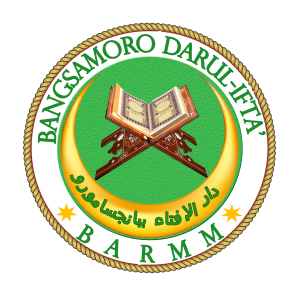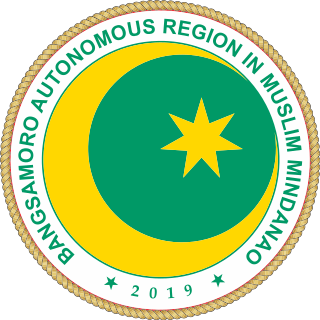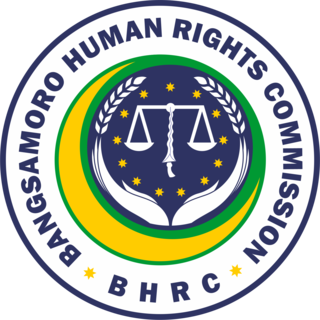
The Autonomous Region in Muslim Mindanao was an autonomous region of the Philippines, located in the Mindanao island group of the Philippines, that consisted of five predominantly Muslim provinces: Basilan, Lanao del Sur, Maguindanao, Sulu, and Tawi-Tawi. It was the only region that had its own government. The region's de facto seat of government was Cotabato City, although this self-governing city was outside its jurisdiction.

Shariff Aguak, officially the Municipality of Shariff Aguak, is a 3rd class municipality in the province of Maguindanao del Sur, Philippines. According to the 2020 census, it has a population of 33,982 people.

Talitay, officially the Municipality of Talitay, is a municipality in the province of Maguindanao del Norte, Philippines. According to the 2020 census, it has a population of 17,463 people.

Mamasapano, officially the Municipality of Mamasapano, is a 5th class municipality in the province of Maguindanao del Sur, Philippines. According to the 2020 census, it has a population of 27,807 people.

Datu Montawal, officially the Municipality of Datu Montawal, is a 5th class municipality in the province of Maguindanao del Sur, Philippines. According to the 2020 census, it has a population of 37,314 people.

Datu Saudi Ampatuan, officially the Municipality of Datu Saudi Ampatuan, is a 4th class municipality in the province of Maguindanao del Sur, Philippines. According to the 2020 census, it has a population of 31,060 people.

Datu Unsay, officially the Municipality of Datu Unsay, is a 5th class municipality in the province of Maguindanao del Sur, Philippines. According to the 2020 census, it has a population of 12,890 people.

Datu Anggal Midtimbang, officially the Municipality of Datu Anggal Midtimbang, is a municipality in the province of Maguindanao del Sur, Philippines. According to the 2020 census, it has a population of 28,224 people.

ARMM Regional Assembly, also known as ARMM Regional Legislative Assembly, was the devolved unicameral regional legislature of the Autonomous Region in Muslim Mindanao (ARMM). It was known as the "Little Congress" of the ARMM.

Shariff Saydona Mustapha, officially the Municipality of Shariff Saydona Mustapha, is a municipality in the province of Maguindanao del Sur, Philippines. According to the 2020 census, it has a population of 25,080 people.

The Bangsamoro Parliament is the legislature of Bangsamoro, an autonomous region of the Philippines. It is currently led by the Bangsamoro Transition Authority, an interim regional governing body. The inaugural session of the parliament took place on March 29, 2019, while its first regular session is projected to take place in 2025.

The Bangsamoro Government Center, also known as the Bangsamoro Office, is a complex of government buildings in Cotabato City, Philippines. The complex serves as the office of the regional government of the Bangsamoro Autonomous Region in Muslim Mindanao.

An autonomous region of the Philippines is a first-level administrative division that has the authority to control a region's culture and economy. The Constitution of the Philippines allows for two autonomous regions: in the Cordilleras and in Muslim Mindanao. Currently, Bangsamoro, which largely consists of the Muslim-majority areas of Mindanao, is the only autonomous region in the country.

The Seal of the Autonomous Region in Muslim Mindanao was the official insignia of the government of the Autonomous Region in Muslim Mindanao, Philippines.

The Bangsamoro Darul Ifta' (BDI-BARMM) is an Islamic advisory council which has jurisdiction over the Bangsamoro Autonomous Region in Muslim Mindanao.

The flag of Bangsamoro is the flag which represents the Bangsamoro Autonomous Region in Muslim Mindanao, an autonomous region of the Philippines.

The Emblem of Bangsamoro is the official insignia of the Bangsamoro Autonomous Region in Muslim Mindanao, an autonomous region in the Philippines.
The Bangsamoro Hymn is the regional hymn of the Bangsamoro Autonomous Region in Muslim Mindanao, an autonomous region in the southern Philippines.

The Bangsamoro Human Rights Commission is a government agency on human rights with jurisdiction over the Bangsamoro Autonomous Region in Muslim Mindanao (BARMM) in the Philippines.




















